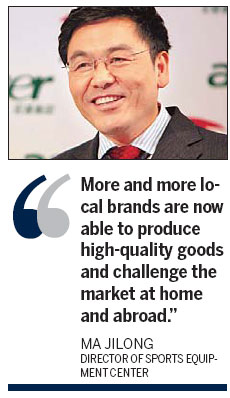Top News
The 'goods' life in China
By Chen Xiangfeng (China Daily)
Updated: 2011-05-08 07:50
 |
Large Medium Small |
|
A billboard on display during the 2010 China International Sporting Goods Show. China's sports goods industry is developing rapidly and is aiming to gain a greater market share. [Photo from Zhongti] |
The sports goods industry here has been progressing rapidly and local brands are taking the opportunity to enhance their competitiveness to challenge the world's leading companies, Chen Xiangfeng reports.
A leading official from the Sports Equipment Center, under the State General Administration of Sport, admits China's sports goods industry is lagging behind developed countries, but believes its huge potential will make it one of the most prosperous industries in China in the near future.
"In the next 10 to 20 years, the sports goods industry in China will be one of the most dynamic and most developed in the country," said Ma Jilong, director of the center during a recent interview with China Daily.
"There are many factors to back this up. Firstly, China's economic development has boosted the sports industry in a number of areas. Secondly, the hugely increased demand for sports and culture has stirred the consumption of sports goods. The third reason is the remarkable influence of the Beijing Olympic Games," Ma said.
"The success of Beijing Olympics has encouraged more Chinese cities to host international sports events and that is having a big impact in changing the habits of the people in these cities. People are getting to know more about different sports and are choosing to get involved."
Sports shoes are a prime example of this.
In China, more than 10 manufacturers sell about 10 million pairs of sports shoes apiece each year; nearly 100 companies from home and abroad sell hundreds of thousands or even several million pairs of shoes each year.
According to the data from the China Industry Research Institute, in 2009 the sales volume of China's sporting goods industry had exceeded 100 billion yuan ($15.4 billion), and it is expected that 250 billion yuan will be achieved in 2013.
"Therefore, the potential of the market is very large," Ma said.

Huge demand as well as rapid economic growth has seen a number of Chinese sports brands rise up and challenge the world's leading names, like Nike and adidas.
Li-Ning ranked second in the industry with 8.387 billion yuan in annual sales volume in 2009, which for the first time exceeded adidas as it squeezed into the ranks of industry leaders.
Nike, Li-Ning and adidas have formed a new upper tier in the country.
"The competition between Chinese and foreign brands has begun to have an affect on the Chinese sporting goods market, which was dominated by foreign brands. More and more local brands are now able to produce high-quality goods and challenge the market at home and abroad," Ma said.
Ma said his center is making efforts to encourage local brands to go abroad and earn greater shares of the international market.
"The domination of international brands has been broken. We are working to have more Chinese brands go abroad and compete with them. Our Chinese brands will earn more rights, get involved in more international competitions and increase their presence in a broader way."
But Ma admitted the domestic market was still at the forefront of fierce competition, which brings chances as well as challenges.
"Those big international brands still see China as the most important market. They are changing their strategies in order to gain more market share in China's second and third tier cities.
"Chinese brands must make extra efforts to face the challenge in some small cities, which are the key areas for us. Such a situation is a challenge as well as an opportunity for us. Some small brands will be eliminated while some brands like Li-Ning and Anta should grab the chance to enhance their competitiveness.
"In the US, there are only a few of big brands. It will be the same in China. In the future it will be impossible to have so many local brands. Some will die and some will grow up to become international-level brands."
Sports goods show
One of the platforms which highlights the competition between Chinese and international brands is the annual China International Sporting Goods Show (CISGS), which was initiated by Ma's center 18 years ago.
The 2011 show will be held from May 13-16 at the New International Convention and Exposition Center in Chengdu, Sichuan province.
Ma said more than 1,000 enterprises from more than 30 countries and regions had confirmed their participation in the show, which will feature about 5,000 booths exhibiting products in six categories, including sportswear, sports equipment, accessories and stadium facilities.
"The entire expanse of the New Chengdu International Convention and Exposition Center, covering a total of 100,000 sqm, was completely booked," said Ma. "The CISGS 2011 is likely to reach historic new heights."
To provide a special platform for brands from home and abroad, Ma is also planning to hold some single-sport goods, shows like the Marathon Expo, which is held during the Beijing International Marathon.
"We are working to produce sports goods shows that have no ending. No ending does not mean we are holding a show over a longer time frame. It means we will set up more shows for one or two sports.
"We are going to have one such kind of special show every month. The shows will feature different sports throughout the year like the Golf Expo, Soccer Expo, the Tennis Expo or the Badminton Expo.
"With the increasing number of popular and major international events held in China, we will use to promote expos. The expositions should then further popularize the sport. The public will get to know more about the sport through the expo and become potential consumers of the sport's goods."
| 分享按钮 |
